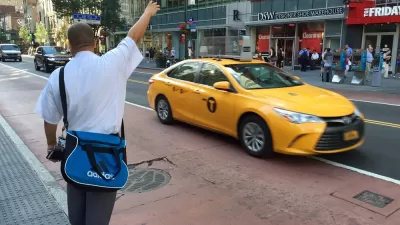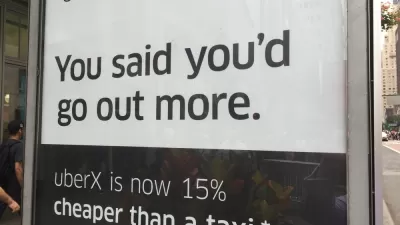There are two schools of though t when it comes to whether Uber and other companies like it are making traffic better or worse. A new study by new York City will endeavor to clear the air.
Carl Bialik takes an in-depth, data-focused look at the congestion implications of transportation network companies like Uber—especially in light of the recent controversy in New York City when Mayor Bill de Blasio proposed a cap on the number of "for-hire" drivers in the city.
After noting that the "city will move ahead with a four-month study of the for-hire industry, examining how it has affected traffic, air quality, noise and public health," Bialik examines the spotty and unreliable data currently available about the impacts of Uber. So, for instance, fewer cars are entering Manhattan, but the cars that are there are traveling much slower.
Bialik notes that both the cities data and Uber's data are murky. The article cites traffic models by Charles Komanoff (who believes that Uber is contributing to worsening congestion in the city, but acknowledges a "very big 'if'"). On the other side is Mark Kleiman, professor of public policy at New York University’s Marron Institute of Urban Management, who thinks that "[e]verybody’s making up stories about how Uber might be bad… but apparently those stories don’t require any evidence whatsoever."
FULL STORY: The Debate On Uber’s Impact In New York City Is Far From Over

Planetizen Federal Action Tracker
A weekly monitor of how Trump’s orders and actions are impacting planners and planning in America.

Congressman Proposes Bill to Rename DC Metro “Trump Train”
The Make Autorail Great Again Act would withhold federal funding to the system until the Washington Metropolitan Area Transit Authority (WMATA), rebrands as the Washington Metropolitan Authority for Greater Access (WMAGA).

DARTSpace Platform Streamlines Dallas TOD Application Process
The Dallas transit agency hopes a shorter permitting timeline will boost transit-oriented development around rail stations.

Renters Now Outnumber Homeowners in Over 200 US Suburbs
High housing costs in city centers and the new-found flexibility offered by remote work are pushing more renters to suburban areas.

The Tiny, Adorable $7,000 Car Turning Japan Onto EVs
The single seat Mibot charges from a regular plug as quickly as an iPad, and is about half the price of an average EV.

Supreme Court Ruling in Pipeline Case Guts Federal Environmental Law
The decision limits the scope of a federal law that mandates extensive environmental impact reviews of energy, infrastructure, and transportation projects.
Urban Design for Planners 1: Software Tools
This six-course series explores essential urban design concepts using open source software and equips planners with the tools they need to participate fully in the urban design process.
Planning for Universal Design
Learn the tools for implementing Universal Design in planning regulations.
Municipality of Princeton
Roanoke Valley-Alleghany Regional Commission
City of Mt Shasta
City of Camden Redevelopment Agency
City of Astoria
Transportation Research & Education Center (TREC) at Portland State University
US High Speed Rail Association
City of Camden Redevelopment Agency
Municipality of Princeton (NJ)




























